Atlantic World > The Dutch in New Netherland
- Henry Hudson
- The Dutch and the Indians
- The Dutch and slavery
- The Golden Age
- The purchase of Manhattan
- Peter Stuyvesant
- The Blauw Jan
- The patroonship system
Henry Hudson
An unknown celebrity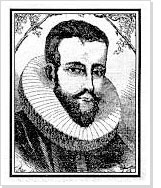 The Englishman Henry Hudson was born in 1570 (some sources say 1550), son of the wealthy London tanner Henry Hudson and his wife Barbara. His grandfather was one of the founders of the English Muscovy Company, an organization that traded with what is presently Russia. Not a great deal is known of Henry Hudson's life. The factual information is limited to the period 1607 to 1611, and all known portraits of him were painted after his death.
The Englishman Henry Hudson was born in 1570 (some sources say 1550), son of the wealthy London tanner Henry Hudson and his wife Barbara. His grandfather was one of the founders of the English Muscovy Company, an organization that traded with what is presently Russia. Not a great deal is known of Henry Hudson's life. The factual information is limited to the period 1607 to 1611, and all known portraits of him were painted after his death.
Hudson probably began his career as an explorer in 1587, when he went in search of the Northwest Passage under the leadership of John Davis. The Northwest Passage was an imagined sea route that supposedly ran along the coast of present-day Canada. The journey was not successful. In 1607, Hudson made his first voyage as captain in the service of the Muscovy Company. This time his orders were to explore the Northeast Passage to China. His superiors thought the journey to the Far East could be made more quickly and under safer conditions by sailing along the northern coast of Russia. Because of the great amount of floating ice he was forced to terminate his journey near the island of Spitsbergen. His second journey brought him no farther than the coast of Nova Zembla, but even so his reputation as an explorer was internationally established.
In the service of the Dutch East India Company
In 1609 he entered the service of the Dutch East India Company, or the VOC (Verenigde Oost-Indische Compagnie). The VOC was trying to build up a trade network in Asia but was thwarted in its efforts by the Portuguese, who had discovered the sea route to Asia around the Cape of Good Hope in 1500. This gave them control of the spice trade between Asia and Europe. In order to avoid the Portuguese and their warships, both the Dutch and the English tried to reach Asia via a northern route.
Hudson was given the order to further explore the northern route. On 6 April 1609 he left Amsterdam with the ship De Halve Maen (The Half Moon), bound for the northeast. The ship quickly ran aground in the pack ice and Hudson was forced to change course. He had been expressly told by the Lords XVII (the board of directors of the East India Company) that in such an event he was to return to Amsterdam. Instead he decided to make a new attempt at finding the Northwest Passage. But events took another turn.
On 18 July he reached the coast of Maine. After the ship, badly damaged by storms, had been patched up, he sailed farther south along the coast. On 3 September he passed the present Staten Island and entered a broad river that would later bear his name. After sailing for some time he discovered that this river did not lead to the fabled India. He did meet some of the local inhabitants, however. These contacts were friendly for the most part, and the inhabitants offered him pelts in exchange for various metal objects. Hudson used the island that they called Manna Hatta as a base from which he explored the rest of the area.
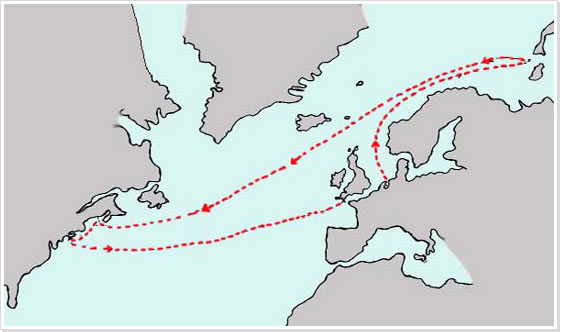
One month later he set sail for the Netherlands. When the ship approached England, the crew, who were mostly English, forced him to put in at the port of Dartmouth. A great many of the English crew then abandoned ship. While awaiting money for a replacement crew, Hudson wrote a report to the Lords XVII in Amsterdam. He described the region he had discovered as 'a land of milk and honey'.
As soon as the English authorities realized that Hudson, while in the service of the VOC, had been exploring an area that they claimed for the English crown, they had him arrested. He was then forced to sail for the Muscovy Company once again.
A miserable death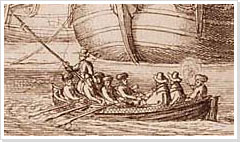 In 1610 he returned to North America, still searching for the Northwest Passage. It was an unhappy voyage. Bad weather forced the expedition to winter in Penobscot Bay, and as he prepared to set sail once again in the spring of 1611 a mutiny broke out. Hudson and eight other crew members were forced to leave the ship in an open sloop. They were never heard from again.
In 1610 he returned to North America, still searching for the Northwest Passage. It was an unhappy voyage. Bad weather forced the expedition to winter in Penobscot Bay, and as he prepared to set sail once again in the spring of 1611 a mutiny broke out. Hudson and eight other crew members were forced to leave the ship in an open sloop. They were never heard from again.
The Dutch and the Indians
Wild and empty?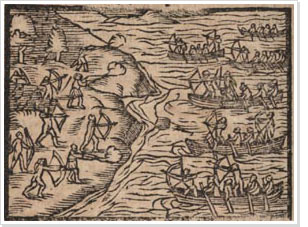 New Netherland was not uninhabited. That was obvious to the first Dutchmen who arrived with Henry Hudson in 1609. The local population paddled out in canoes to meet them.
New Netherland was not uninhabited. That was obvious to the first Dutchmen who arrived with Henry Hudson in 1609. The local population paddled out in canoes to meet them.
It is not very likely that the seamen had ever heard any preaching by the reverend Godefridus Udemans (1580-1649). Earlier on he had declared from the pulpit that the New World was not all that new. 'It has been inhabited since ancient times'. Udemans got his information from the many documents, books and maps that were being printed and distributed in the Netherlands. The cartographer Johannes de Laet (1582-1649) had written that the local population was friendly and prepared to engage in trade, as long as they were treated with respect.
Conducting trade: the rules of the game
The Directors of the West India Company gave explicit orders to the Dutch people who began settling the region in 1624 to treat the Indians in a friendly manner. Governor Willem Verhulst was told in his instructions that he must be 'honest, trustworthy and fair-minded' in his dealings with the Indians. The later sale of the island of Manhattan was also concluded in conformity with the instructions 'that such transactions must satisfy the local Indians'. It was not always possible for the Dutch to yield to the Indians' wishes, however. An example is the refusal of the Mohicans to grant colonists leave to enter their maize land, blocking the planned expansion of Dutch building projects.
The strict attitude of the WIC officials was partly inspired by their religious views. Their obedience was motivated not only by their fear of angering the Directors should they fail to comply, but even more so by the fear that 'the wrath of God would be called down because of their conduct', a phrase included in their instructions.
Increasing pressure on the Indians and the consequences
The steady influx of Europeans increased the pressure on Indian tribal lands. More and more, the inhabitants were being confronted by colonists and their weapons. They also had to deal with Europeans who refused to abide by the 'precise instructions' of the WIC. Traders discovered that alcohol greatly influenced the Indians. After a bottle of jenever, the prices being offered for furs were more quickly accepted. The WIC tried to stop these traders but were unsuccessful. As a result, the use of alcohol spelled disaster for many tribes.
The number of incidents between the Indians themselves and between Indians, colonists and traders grew steadily. Some of these incidents evolved into total war. This occurred in 1626 when a number of Dutchmen from Fort Oranje (the present Albany), accompanied by a group of Mohicans, attacked a Mohawk encampment. For the Indians being attacked this meant that the Dutch had abandoned their impartiality. In response the Mohawks struck back, killing four Dutchmen. To avoid further escalation, all the parties involved hastened to draw up a new peace treaty.
War and peace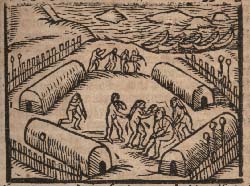
 In an ensuing conflict in 1632, the Dutch settlement of Swanendael (Delaware) was wiped out by the Algonquins. Here, too, the parties were not able to carry on the fight and peace was quickly concluded. The personality of the governor played an important role in the relationship between the colonists and the native inhabitants. Governor Willem Kieft (1597-1647) tried to impose taxes on the Indians, which led to an outbreak of hostilities that later became known as 'the Kieft War'. For two years (from 1643 to 1645), people of the Raritan, Canarsie, Hackensack, Tappan, Wechquasgeck and Mohawk tribes fought with each other and against the Dutch.
In an ensuing conflict in 1632, the Dutch settlement of Swanendael (Delaware) was wiped out by the Algonquins. Here, too, the parties were not able to carry on the fight and peace was quickly concluded. The personality of the governor played an important role in the relationship between the colonists and the native inhabitants. Governor Willem Kieft (1597-1647) tried to impose taxes on the Indians, which led to an outbreak of hostilities that later became known as 'the Kieft War'. For two years (from 1643 to 1645), people of the Raritan, Canarsie, Hackensack, Tappan, Wechquasgeck and Mohawk tribes fought with each other and against the Dutch.
The Mohawks finally succeeded in concluding a new treaty with all the parties involved. This was a happy event for surgeon Harmen Meyndertsz van den Bogaert, one of the first Dutchmen to wander around the Indian territory from 1634 to 1635 and live among the inhabitants. Van den Bogaert, father of four children, later fled from his former home when he was accused of sodomy in 1647. He was charged with having had a relationship with his black servant Tobias. After his pursuers finally had him arrested he managed to escape. He fled over a frozen river, but halfway across the ice broke and he drowned in the icy water.
Kieft's successor, the celebrated Peter Stuyvesant, was also involved in bloody fighting with the Indians between 1655 and 1664. The Eosopus tribe were the last to 'take up the tomahawk against the Dutch'. After 1664 the British assumed control of the colony and continued the fight against the peoples of 'the first nation'.
The Dutch and slavery in New Netherlands
Were the Dutch the first ones?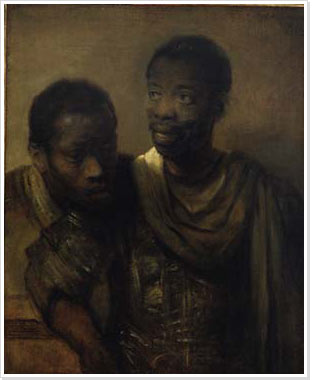 According to many American history books, the Dutch were the first to bring enslaved Africans to the shores of Virginia in 1619. John Rolfe, resident of Jamestown, noted in his diary that about twenty black people had been brought to the settlement in a Dutch man-of-war. John Pory describes the same event in a letter. As a result, some people now pin the responsibility for this act on the Dutch navy. This is impossible, however, for the simple reason that there was no Dutch navy at that time.
According to many American history books, the Dutch were the first to bring enslaved Africans to the shores of Virginia in 1619. John Rolfe, resident of Jamestown, noted in his diary that about twenty black people had been brought to the settlement in a Dutch man-of-war. John Pory describes the same event in a letter. As a result, some people now pin the responsibility for this act on the Dutch navy. This is impossible, however, for the simple reason that there was no Dutch navy at that time.
The ship by which the unfortunate Africans came to America was in all probability the Trier, a pirate ship from Vlissingen. The Trier and the English pirate ship the Treasurer had overtaken the Portuguese slave ship the Sao Joa Bautista, which was on its way from Angola to South America. Both ships plundered the Portuguese ship and then sped on to Jamestown to sell their human booty. The Dutch ship was just a bit faster than the English.
The Dutch slave trade and slavery
This was not the end of the matter, however. As soon as the WIC decided to expand the Dutch settlement on the island of Manhattan, they decided to import African slaves. The first Africans arrived in 1624. These were about a dozen men and an unknown number of women. Most had been taken prisoner on Spanish ships somewhere in the Caribbean by WIC privateers. In New Netherland they were used as farm labour, in public works and in the building of Fort Amsterdam. All African 'company slaves' were the property of the WIC and were not sold privately at first. When the company later began to experience serious financial problems, the slaves were hired out by the official WIC overseer to private colonists. Sometimes they were put to work as soldiers in the unremitting wars with the Indian tribes. This was a departure from the system of private slave ownership that was prevalent in the New World. The company slaves were given a number of limited rights that were laid down in law. Perhaps the most important of these rights was that after the passage of time they were given their freedom. These freed slaves were then given a piece of land on which to settle and to support themselves. It is known that a group of slaves were freed in 1664, after which they settled in the vicinity of the present Canal Street and Astor Place. Thus in the mid-seventeenth century small communities of free blacks were formed in New Amsterdam.
Elsewhere in the Atlantic region, Dutch involvement in the trans-Atlantic slave trade began in around 1635. The WIC transported the enslaved Africans from the west coast of Africa to the colonies in Brazil, which had been captured by the Dutch from the Portuguese. The Africans were put to work cultivating sugarcane on the plantations. When the Portuguese re-captured Brazil in 1653, Africans were brought to the Dutch colonies of Suriname and Curaçao.
The Golden Age
The concept Between the mid-sixteenth and the mid-seventeenth centuries there were signs of enormous and rapid economic growth in the Republic. The arts and sciences underwent a period of unprecedented development, and Dutch ships were exploring the world. During this period, which is commonly referred to as 'the Golden Age', the Republic was among the most powerful countries in Europe.
Between the mid-sixteenth and the mid-seventeenth centuries there were signs of enormous and rapid economic growth in the Republic. The arts and sciences underwent a period of unprecedented development, and Dutch ships were exploring the world. During this period, which is commonly referred to as 'the Golden Age', the Republic was among the most powerful countries in Europe.
There has been quite some discussion concerning exactly when the Golden Age began and how long it lasted. It is generally agreed, however, that this important period largely coincided with another event in Dutch history: the Revolt.
The Revolt and the run-up to the Golden Age
In the sixteenth century, the Low Countries were part of the Spanish Empire. After the abdication of emperor Charles V in 1555, his son Philip II took over the imperial leadership. Philip was saddled with a rapidly growing Protestant movement and a struggle for greater autonomy in the northern regions of the Low Countries. He responded to these developments by forcefully suppressing Protestantism and centralizing administrative power in Brussels as much as possible. This led to great political and religious tension in the Low Countries.
In 1566 the bomb burst and the interiors of Catholic churches in several places in the Netherlands were vandalized. This 'beeldenstorm', or iconoclastic attack, would become the prelude to a revolt in the northern regions. The battle of Heiligerlee two years later between Spanish armies and the troops of the Prince of Orange was the formal starting point of a struggle that was to last for eighty years. At the Peace of Münster (1648), the Spanish formally recognized the independence of the northern Low Countries.
War and economic growth The revolt against 'the Spanish tyranny' did not get in the way of economic development in the northern Low Countries. Since the beginning of the sixteenth century, trade with the Baltic region had been increasing steadily. Ships from various Dutch cities around the Zuiderzee participated in this trade, and Amsterdam developed into the principal entrepôt in the flow of goods.
The revolt against 'the Spanish tyranny' did not get in the way of economic development in the northern Low Countries. Since the beginning of the sixteenth century, trade with the Baltic region had been increasing steadily. Ships from various Dutch cities around the Zuiderzee participated in this trade, and Amsterdam developed into the principal entrepôt in the flow of goods.
After the Spanish captured the important harbour of Antwerp in 1585, some of the wealthy population fled the city. The refugees who went to Amsterdam brought more than their capital with them. They also brought knowledge of and contact with European mercantile houses and banks. This influx of refugees strengthened Amsterdam's share in the European trade network and brought about a new period of economic growth for Amsterdam and the surrounding cities. When northern insurgents closed off access to Antwerp (the mouth of the Schelde), the centre of gravity for trade in the Low Countries shifted to Amsterdam in the north and remained there for quite some time.
The Dutch and the oceans of the world
With the establishment of the Dutch East India Company (1602) and the West India Company (1621), the northern Low Countries gained access to the Asian, Arabian, African, Caribbean and American markets. Spices, gold, ivory, textiles, silk, porcelain and sugar filled the Amsterdam warehouses. From 1635 onwards, the West India Company played a role in the infamous slave trade. Enslaved Africans were forcibly shipped to plantations in the Caribbean.
Overseas trade was not a dominant feature of the Dutch economy, however. Most money was earned closer to home in Europe. But international trade did contribute to the spreading of knowledge. At first this took place in the form of globes, cartographic material and travelogues. These were soon followed by books and pamphlets on a great variety of subjects. The acquired knowledge was then taught at the universities of Leiden, Utrecht, Amsterdam and Harderwijk.
Abundance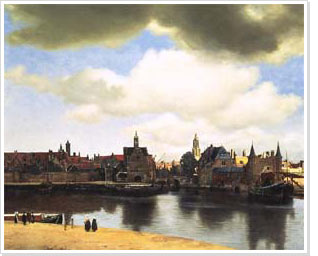 The availability of so much capital also made it possible to undertake costly enterprises, such as the draining of Holland's great lakes. The fertile land thus obtained supplied the 'burgers' who had funded the enterprises with rich harvests.
The availability of so much capital also made it possible to undertake costly enterprises, such as the draining of Holland's great lakes. The fertile land thus obtained supplied the 'burgers' who had funded the enterprises with rich harvests.
Not all the money was invested in the economy. The initial modesty that characterized the merchants, many of whom were Protestant, was replaced by a greater concern for appearances.
More and more money was spent on the building of expensive houses, household goods, clothing, art and culture. The output of Dutch painters such as Rembrandt, Vermeer and Steen graced the elegant interiors of the canalside houses and country estates of the wealthy. Sculptors and furniture makers also contributed to the colourful excess that is so characteristic of the Golden Age. In the city of Amsterdam the most valuable treasures of the Western World were on display. But the days of abundance were numbered.
Decline
In the middle of the seventeenth century, the Republic was confronted by heavy competition from upcoming 'mercantile' powers such as France and England. Because of an oversupply of cargo space and dropping prices for their products, Dutch traders found themselves in a slowly descending spiral. When the Republic was drawn into war with France, England and the bishops of Munster and Cologne in 1672, the 'Year of Calamity', it came as a deathblow to the Dutch economy and to the Golden Age.
The purchase of Manhattan
Myth or Swindle?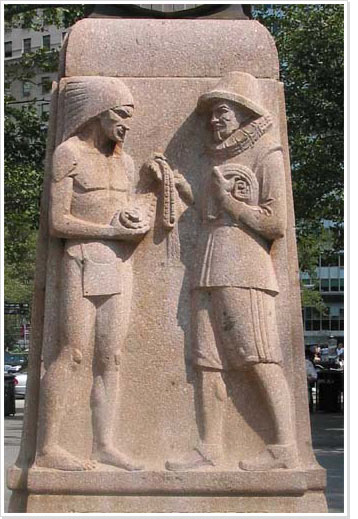 The story of the purchase of the island of Manhattan is legendary. Most people see it as proof of how the simple American Indians were hoodwinked by those crafty Europeans.
The story of the purchase of the island of Manhattan is legendary. Most people see it as proof of how the simple American Indians were hoodwinked by those crafty Europeans.
At the end of the nineteenth century, various American historians and writers published several different versions of the story of the purchase, which took place in the early seventeenth century. The pictures illustrating these articles feature Dutch people in dark seventeenth-century garb, complete with hats. Their partners in the negotiations resemble nineteenth-century inhabitants of the Midwestern prairies. The Dutchmen bought the island for twenty-four American dollars' worth of beads and mirrors, or so the story goes. The question, however, is whether this account of the event is based on fact.
The only proof
The archives of the Netherlands and the United States contain no receipts or deeds of transfer that might serve as proof of purchase. In the National Archives in The Hague, however, there is a letter that refers to the purchase of the island. The letter was written by Pieter Schagen and is dated 5 November 1626. Schagen was a member of the council of Alkmaar, delegate of the district Holland, Noorderkwartier (Northern dwelling), and member of the States General. In addition, he was a representative of the States General in the college of de Heren XIX van de West-Indische Compagnie (the XIX Lords of the West India Company). In his function as representative he wrote the letter to the States General referring to the earlier purchase. He started telling how the Dutch men and women living on the island had been faring up until then. He also reports: 'have bought the island of Manhattes from the savages for a value of 60 guilders'. This passage in Schagen's letter is the only source that directly refers to the controversial purchase of the island. There is no mention of payment in worthless beads or mirrors, nor does the letter say who it was that purchased the island on behalf of the Dutch or who may have sold it on behalf of what Indian group. We do know that at the time of purchase, Peter Minuit (1580-1638) was governor of New Netherland. In all probability members of the Lenape tribe were involved in the transaction.
The price of land
Documents do exist for the purchase of another island, Staten Island. There the sale was finalized with local Indians through payment in kind of a similar amount (sixty guilders). The articles the Indians received consisted of duffel, cauldrons, axes, hoes, awls, Jews' harps and wampum (Indian beads, which functioned as currency). Each item was regarded by the recipients as something of great value. It is virtually impossible to determine the objective value of the goods that were traded. On the basis of Schagen's letter, we know that the exchange value of the goods was sixty Dutch guilders. But take note: that was the price for the Dutch sellers. The actual value of the goods for the recipients cannot be ascertained today. It is unlikely, however, that they would have agreed to sell if the offer had been too low.
Indians and ownership rights
There is yet another factor at issue, however. The original inhabitants of the area were unfamiliar with the European notions and definitions of ownership rights. For the Indians, water, air and land could not be traded. Such exchanges would also be difficult in practical terms because many groups migrated between their summer and winter quarters. The Dutchmen were well-versed in these concepts, of course, and they had also been given explicit instructions from their directors to respect the rights of the original inhabitants and to avoid conflict. So it was perfectly consistent with this line of thinking to offer to buy the Indians' land. In doing so they would be complying with their instructions - in conformity with the current notions of ownership rights.
It can be concluded that both parties probably went home with totally different interpretations of the sales agreement.
Transcription Schagen letter
Recep.7 November 1626
High and Mighty Lords,
Yesterday the ship the Arms of Amsterdam
arrived here. It sailed from New Netherland out
of the River Mauritius on the 23d of September.
They report that our people are in good spirit
and live in peace. The women also have borne
some children there. They have purchased the
Island Manhattes from the Indians for the value
of 60 guilders. It is 11.000 morgens in size
[about 22.000 acres]. They had all their grain
sowed by the middle of May, and reaped by the
middle of August They sent samples of these
summer grains: wheat, rye, barleey, oats,
buckwheat, canary seed, beans and flax. The
cargo of the aforesaid ship is:
7264 Beaver skins
178 ½ Otter skins
675 Otter skins
48 Mink skins
36 Lynx skins
33 Minks
34 Weasel skins
Many oak timbers and nut wood. Herewith,
High and Mighty Lords, be commended to the
mercy of the Almighty,
Your High and Mightinesses' obedient
P. Schagen
Peter Stuyvesant
Who was Peter Stuyvesant
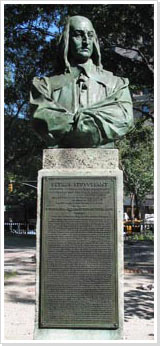 Many people are familiar with the name Peter Stuyvesant, yet relatively little is known about him and no reliable biography of him exists. He was born in all probability in 1610 in the Frisian village of Stellingwerf. He studied literature and philosophy at the University of Franeker but had to cut short his school career because of 'an affair' with a girl.
Many people are familiar with the name Peter Stuyvesant, yet relatively little is known about him and no reliable biography of him exists. He was born in all probability in 1610 in the Frisian village of Stellingwerf. He studied literature and philosophy at the University of Franeker but had to cut short his school career because of 'an affair' with a girl.
One of his father's associates found him a job with the Dutch West Indian Company in Amsterdam, where he attracted attention (in the positive sense) because of his diligence. After a short period in Brazil he left for the island of Curaçao in 1638. In the period between 1640 and 1795 an estimated ninety thousand Africans passed through Curaçao, to be sold as slaves. In 1643 Stuyvesant was appointed director of the island. He was ordered by the WIC to capture the island of Sint Maarten from the Spanish, but the campaign failed. Stuyvesant lost his right leg in battle and had himself measured for a wooden prosthesis with silver fittings.
In 1644 he left Curaçao to return to Holland and recover from his injury. There he married Judith Bayard. The couple had two sons, Balthasar Lazarus in 1647 and Nicolaes Willem in 1648.
Assigned to New Netherland
After being appointed governor of the colony of New Netherland and the Antilles in 1647 he let it be known that he was someone to be reckoned with. Contemporaries describe him as a conceited, egotistical, arrogant man with little cultural refinement. It soon became evident that these characteristics would continue to influence his work. Commenting on his style of leadership, a director of the WIC wrote, 'Our great Muscovy Duke is carrying on as usual. He's just like a wolf whose tendency to bite increases with age.' It was his habit during meetings to bang his wooden leg on the floor every now and then whenever he did not agree with the way things were going.
He issued a prohibition on the sale of alcohol to the Indians, and he also prohibited the sale of alcohol after nine o'clock at night. To increase the colony's revenues he imposed an excise tax on wine and other alcoholic drinks. All furs intended for the fur trade had to be stamped in an effort to discourage smuggling, and a thirty-cent tax was levied on every fur that was sold.
Stuyvesant went to great lengths to limit religious freedom in the colony and to compel the inhabitants to attend the Dutch Reformed church. He mercilessly persecuted Lutherans, Baptists, Jews and Quakers until public opinion in the colony and the Directors in Amsterdam forced him to assume a more moderate attitude.
He attempted to bring about better economic cooperation between the Caribbean island and New Netherland. New Netherland would provide food for the islands in return for a steady supply of horses, salt and slaves. The plan ended in failure, however, because the islands discovered that it was more profitable to trade within their own region.
Conflicten aplenty
A conflict arose over a piece of land that Adriaen van der Donck had purchased from the Company. Van der Donck was an opponent of quite some stature. He was a lawyer and secretary of the Council and was more than capable of taking a stand against Stuyvesant. This he did by writing a devastating report on conditions in the colony. Back in the Republic he attempted to defend himself against Stuyvesant with his 'Vertoogh van Nieu Nederland' (Exposé of New Netherland), which made a deep impression. But it did nothing to solve the problem of the authoritarian governor, and Van der Donck returned to the colony disappointed.
The governor possessed unbridled energy. With great shrewdness he settled the long-standing border conflict that had existed with the English in the north and the Swedes in the south. The English were too strong to be dealt with militarily, so he drew up a treaty with the colonists of Connecticut. His approach to the problem with the Swedes on the Delaware River to the south was completely different. In 1655, after having been given permission from the WIC, he approached the Swedish settlement with six hundred soldiers in seven ships. The Swedes surrendered immediately and the colony became Dutch territory.
War with the Indians
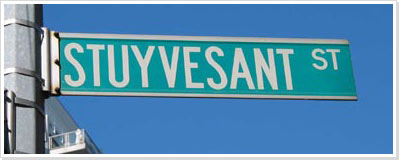 Upon returning to New Amsterdam from his Delaware expedition, he was confronted by a fierce conflict with the local Indians. The immediate cause of the conflict was that a Dutch farmer had caught an Indian woman stealing peaches from his orchard. The farmer shot and killed the woman, and the family of the woman demanded compensation in return. At first Stuyvesant succeeded in keeping the matter under wraps, but not for long. In 1658 the so-called Peaches War broke out, in which the various Indian tribes fought side by side against the colonists.
Upon returning to New Amsterdam from his Delaware expedition, he was confronted by a fierce conflict with the local Indians. The immediate cause of the conflict was that a Dutch farmer had caught an Indian woman stealing peaches from his orchard. The farmer shot and killed the woman, and the family of the woman demanded compensation in return. At first Stuyvesant succeeded in keeping the matter under wraps, but not for long. In 1658 the so-called Peaches War broke out, in which the various Indian tribes fought side by side against the colonists.
The end of the colony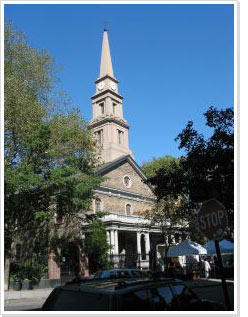 The colony grew steadily under Stuyvesant's rule. The population increased to about nine thousand and intensive trade was carried on with the Republic, especially Amsterdam. But the pressure on New Netherland from the surrounding English colonies increased as well. More and more English colonists, armed or not, managed to penetrate Dutch territory. In the meantime, war broke out again between the two home nations on the North Sea. In August 1664 four English war ships appeared off the coast of New Amsterdam. Stuyvesant had no choice but to hand the colony over to the English.
The colony grew steadily under Stuyvesant's rule. The population increased to about nine thousand and intensive trade was carried on with the Republic, especially Amsterdam. But the pressure on New Netherland from the surrounding English colonies increased as well. More and more English colonists, armed or not, managed to penetrate Dutch territory. In the meantime, war broke out again between the two home nations on the North Sea. In August 1664 four English war ships appeared off the coast of New Amsterdam. Stuyvesant had no choice but to hand the colony over to the English.
He spent the last years of his life with his wife and married sons on his 'bouwerij' (farm) in the re-named colony of New York. He was buried in 1672 (some sources say 1682) in the chapel near his home. The original building burnt down in the eighteenth century and was replaced in 1799 by the present church. New Netherland's most famous governor lies there still.
The Blauw Jan
The wonders of nature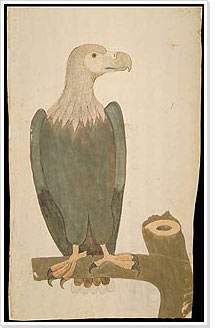 Starting in the mid-sixteenth century Dutch ships began venturing farther and farther across the oceans. Once back in their home ports, the crew members told stories of the many wondrous things they had seen along the way. The interest in these stories was enormous. Merchants were eager to learn all they could about trade possibilities with distant lands, cartographers were hungry for facts about newly discovered regions, and collectors tried to purchase the exotic objects these travellers had brought home. Almost everyone was curious about the 'cannibals' and 'carnivorous animals' that had threatened the lives of many an 'honest sailor'.
Starting in the mid-sixteenth century Dutch ships began venturing farther and farther across the oceans. Once back in their home ports, the crew members told stories of the many wondrous things they had seen along the way. The interest in these stories was enormous. Merchants were eager to learn all they could about trade possibilities with distant lands, cartographers were hungry for facts about newly discovered regions, and collectors tried to purchase the exotic objects these travellers had brought home. Almost everyone was curious about the 'cannibals' and 'carnivorous animals' that had threatened the lives of many an 'honest sailor'.
With quite some regularity the ships brought exotic animals back with them. Some of the animals were still alive, but more often than not they had died en route and been stuffed by the crew. The living and the stuffed animals found their way to menageries (forerunners of today's zoos), collectors' cabinets, travelling exhibitions and, in some cases, inns.
In the port city of Amsterdam there were countless inns in the seventeenth century, and some of them maintained collections of exotic animals. There were other interesting things to see there as well: people who were exceptionally large or very small, or who had a serious physical defect that they could show off. Not all the people who visited the inns came for the sole purpose of alcohol and thrills. The exhibited objects attracted the attention of men of learning from all over Europe.
The Blauw Jan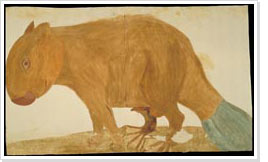 The inn known as the Blauw Jan, which opened its doors on the Kloveniersburgwal in Amsterdam in the mid-seventeenth century, had a large barred cage in the inner courtyard. Upon payment of four stuivers visitors were permitted to see the exotic birds that were kept there. They could also examine the various cabinets containing 'rarities' and 'naturalia' (which included animals and human foetuses preserved in bottles of alcohol), as well as exotic mammals, some of them stuffed. The inn had built up a name for itself throughout Europe because of the regular 'refreshment' of the collection. The managers of the Blauw Jan did not limit themselves to displaying the animals and other objects coming in from distant lands; they traded in them, too. Animals from the inn were sold to the courts of France and Sweden and to the stadholder in The Hague.
The inn known as the Blauw Jan, which opened its doors on the Kloveniersburgwal in Amsterdam in the mid-seventeenth century, had a large barred cage in the inner courtyard. Upon payment of four stuivers visitors were permitted to see the exotic birds that were kept there. They could also examine the various cabinets containing 'rarities' and 'naturalia' (which included animals and human foetuses preserved in bottles of alcohol), as well as exotic mammals, some of them stuffed. The inn had built up a name for itself throughout Europe because of the regular 'refreshment' of the collection. The managers of the Blauw Jan did not limit themselves to displaying the animals and other objects coming in from distant lands; they traded in them, too. Animals from the inn were sold to the courts of France and Sweden and to the stadholder in The Hague.
By 1784 it was all over. When the supply of new animals came to a halt because of the Fourth English War, the inn was sold and shut down.
Jan Velten
In around 1700 the inn was regularly visited by Jan Velten, who made drawings of the exhibited objects and wrote about them. Nothing is known of the background of this nature enthusiast. He certainly was not a trained artist. The pencil drawings he made lack skill and look very much like children's drawings. This is less true of the ink drawings and gouaches. Velten drew the animals and objects being shown in another Amsterdam inn as well. He bound his 265 drawings in a single volume which he called 'Wonderen van de natuur' (Wonders of Nature), which is now located in the Artis library of the Library of the University of Amsterdam.
A real Indian comes to call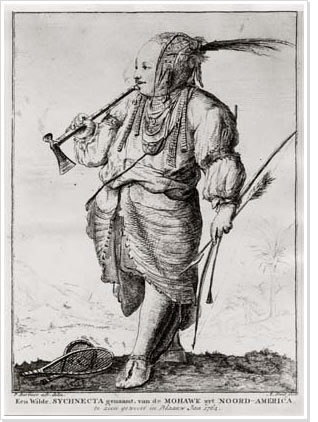
 In the autumn of 1764, a real American Mohawk Indian could be seen at the Blauw Jan. A German living in the Mohawk Valley had joined forced with his neighbours to earn some money in Europe. He reached Amsterdam via England with two Indians. He sold one of them, named Sychnecta, to the manager of the inn who in turn put him on display. Sychnecta was drawn there from life in his traditional costume by the artist Pieter Barbiers. A. Smit made an etching from the drawing. There are few known drawings of 18th century Mohawks, and Barbiers had made one of them, probably without knowing it. Sychnecta returned to the Mohawk Valley in the summer of 1765.
In the autumn of 1764, a real American Mohawk Indian could be seen at the Blauw Jan. A German living in the Mohawk Valley had joined forced with his neighbours to earn some money in Europe. He reached Amsterdam via England with two Indians. He sold one of them, named Sychnecta, to the manager of the inn who in turn put him on display. Sychnecta was drawn there from life in his traditional costume by the artist Pieter Barbiers. A. Smit made an etching from the drawing. There are few known drawings of 18th century Mohawks, and Barbiers had made one of them, probably without knowing it. Sychnecta returned to the Mohawk Valley in the summer of 1765.
The patroonship system
A difficult start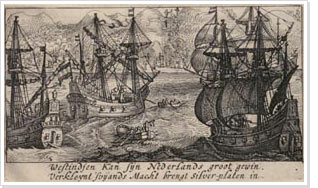 The Dutch presence in New Netherland got off to a difficult start. The West India Company quickly discovered that the exploitation of the area would require enormous investment. The Company was faced with a choice: either develop the area as a colony or be satisfied with the establishment of a limited number of trading posts.
The Dutch presence in New Netherland got off to a difficult start. The West India Company quickly discovered that the exploitation of the area would require enormous investment. The Company was faced with a choice: either develop the area as a colony or be satisfied with the establishment of a limited number of trading posts.
If the WIC chose for the temporary presence of merchants, it would mean avoiding large and expensive investments. The development of a colony, however, was clearly a different story. Sizeable investments would be required to bring over a large number of colonists, cattle, building materials and tools by ship. And the development of an administrative organization, the building of forts and the conveyance of soldiers would be costly items as well. These were investments with no prior guarantee of any returns.
An unavoidable choice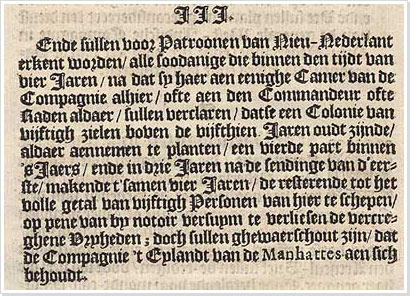 The governing board of the WIC engaged in an extensive debate over what the right choice might be. At first the Lords XIX tried to retain the company's trade monopoly, but wealthy merchants were not prepared to invest their money in such an enterprise. Their willingness to invest depended exclusively on being allowed to develop trade activities according to their own lights. The question dragged on until 1628, four years after the establishment of the colony's principal city, New Amsterdam. The failure to reach a decision brought the colony to the brink of financial ruin.
The governing board of the WIC engaged in an extensive debate over what the right choice might be. At first the Lords XIX tried to retain the company's trade monopoly, but wealthy merchants were not prepared to invest their money in such an enterprise. Their willingness to invest depended exclusively on being allowed to develop trade activities according to their own lights. The question dragged on until 1628, four years after the establishment of the colony's principal city, New Amsterdam. The failure to reach a decision brought the colony to the brink of financial ruin.
Within the Company's board of governors, the faction of merchants led by Kiliaen van Rensselaer finally won the dispute. He succeeded in opening the way for private investors.
Patroons
These investors were given the name 'patroon'. Each patroon was head of a 'patroonship'. Patroons were granted strips of land along the rivers. They were expected to import colonists, cattle and tools to their patroonship from Europe. The allotment of land was generous: a strip of land three miles wide and extending inland as far as the new owner thought reasonable. The patroons were also given juridical authority over their patroonship. They were allowed to appoint representatives, levy taxes and punish colonists - within certain limits. All the products of the area (such as grain, fruit, meat, fish and minerals) were the property of the patroon. This did not apply to the fur trade, however. That remained the exclusive privilege of the WIC.
The new regulations also made it possible for private individuals such as farmers or craftsmen to settle in the colony. No longer were settlers automatically enrolled in the service of the WIC. These private individuals were also entitled to land grants. Such grants were considerably smaller than those given to the patroons, however. Private individuals were given as much land as they could reasonably work.
After a year, when this new policy was still failing to attract a sufficient number of investors, the regulation was readjusted to the patroons' advantage.
Failure and success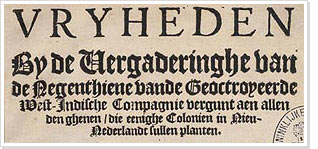 Patroonships were established at a number of places in New Netherland. This was no simple matter. The supply of building materials was limited by the number of ships that maintained the connection between the Republic and the colony. Competition soon developed for the acquisition of scarce available goods. Only a small number of patroonships came into existence. Kiliaen van Rensselaer established a patroonship at present-day Albany and called it Rensselaerswijck. It was the only settlement that continued to function reasonably well until the arrival of the English in 1664.
Patroonships were established at a number of places in New Netherland. This was no simple matter. The supply of building materials was limited by the number of ships that maintained the connection between the Republic and the colony. Competition soon developed for the acquisition of scarce available goods. Only a small number of patroonships came into existence. Kiliaen van Rensselaer established a patroonship at present-day Albany and called it Rensselaerswijck. It was the only settlement that continued to function reasonably well until the arrival of the English in 1664.
